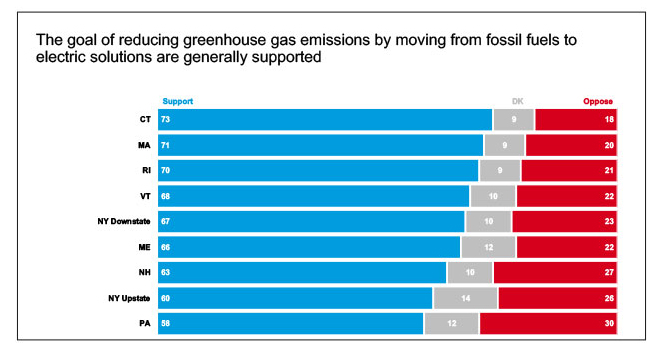
The panel I facilitated at the National Propane Gas Association (NPGA) Southeastern Convention was both extremely popular and highly distressing. Representatives from the Western Propane Gas Association, the Propane Gas Association of New England (PGANE) and the New York Propane Gas Association (NYPGA) detailed the extraordinary ways our industry is under attack in the states they represent. It was sobering, to say the least.
Many in our industry are aware that these states are pursuing aggressive climate change plans that prioritize dramatically reducing carbon emissions. Few appreciate just how aggressive and pernicious these efforts have become, how much they threaten our industry and how fast the river is running.
Playing Whack-A-Mole
In each of these states, association executives describe playing a game of whack-a-mole. Legislators insert climate change language in a bill, and if it’s defeated, the initiative surfaces in the budget process, or in stretch codes, or local bans on fossil fuels, or buried in other legislation.
Laws are passed that set goals for reducing carbon emissions, allowing citizens to sue the state if the goals are not met. They leave the details to be hammered out by special climate committees. These committees end up populated mostly with people who have little experience in energy creation or distribution, but who are passionate believers in fighting climate change at all costs.
Our lobbying efforts feel like David versus Goliath. When an association executive gets wind of a new initiative, they send an urgent email for members to contact their government officials asking that they reject it. Sometimes it works. Increasingly, the momentum is working against us.
While we may have excellent talking points about the overall cleanliness of our fuel, the advent of renewable propane, the many ways it can complement wind or solar, the benefit of its affordability, etc., many legislators feel little compulsion to listen. That’s because of the following:
- Many of them want to do something aggressive to combat climate change, and they have drunk from the electric Kool-Aid
- The true costs, risks and complexities of the plans have been shielded from scrutiny
- Perhaps most importantly, a majority of their district supports these goals
Politicians may be uninformed about many things, but one thing they know how to do is count. And right now, we are on the short end of their calculations.
What Do Voters Think?
Ultimately, to protect our interests and prevent great damage to the public, we have to get people to speak up. We need to counterbalance the loud voices that politicians are hearing from climate activists (amplified by the media) so they will consider more than electrification.
 My firm recently conducted a poll of 3,600 registered voters in eight New England and mid-Atlantic states funded by the NEFI and state oil heat associations. The results highlight the dangers we face, but also illuminate a successful pathway forward. The poll was one of the largest of its kind and has a +/- confidence level of 95%.
My firm recently conducted a poll of 3,600 registered voters in eight New England and mid-Atlantic states funded by the NEFI and state oil heat associations. The results highlight the dangers we face, but also illuminate a successful pathway forward. The poll was one of the largest of its kind and has a +/- confidence level of 95%.
In these states, voters ranked climate change as their second most important issue after inflation. A solid majority of both Democrats and Republicans consider it a threat (though Democrats are more likely to describe it as a “very serious” one). What’s more, when we describe plans in each state to reduce carbon emissions by moving from fossil fuels to electric solutions, a majority in each state support it (between 58% and 73%). This is not lost on legislators.
Propane also suffers from low favorability compared to other alternatives, something that may come as a surprise to those in the industry. When asked to rate different fuel sources for home heat as favorable or unfavorable, propane ranked near the bottom, just ahead of heating oil.
It has a favorable/unfavorable net score of only +6. Electric geothermal and heat pumps ranked at +50 and +43 respectively. Natural gas, which we would consider to be a much closer relative than heating oil, has a +40.
Some Good News
There is another side to this story, however. While a majority support the broad goals of reducing carbon emissions, far fewer have signed up for the specific tactics that are being contemplated.
 When we alert them of the likely implications — forced conversion to heat pumps at a cost of upwards of $20,000, electric rate and energy cost increases, surcharges/carbon taxes on traditional fuels, bans on replacement equipment, increased fragility of the electric grid, etc. — support drops considerably. In most cases, majority support turns into majority oppose.
When we alert them of the likely implications — forced conversion to heat pumps at a cost of upwards of $20,000, electric rate and energy cost increases, surcharges/carbon taxes on traditional fuels, bans on replacement equipment, increased fragility of the electric grid, etc. — support drops considerably. In most cases, majority support turns into majority oppose.
Less than 40% would even support using taxpayer funding to subsidize conversions to heat pumps, and of those, the vast majority don’t want to spend more than $500. Overwhelmingly, people don’t want an outright ban on these fuels.
Engaging the Public
The findings from this research give us a roadmap for ensuring a future that includes propane gas everywhere. In the end, we will need to improve the way propane is perceived, and renewable propane will play an important role in this. But first we need to slow the political freight train down. That will only happen if we do a good job of alerting the public to the real downsides of the current carbon emission reduction schemes.
They have mostly been sold a bill of goods. Benefits have been inflated, technological challenges downplayed, costs completely underestimated or obscured, alternatives relegated to the scrap heap if they include combustion. Only by educating the public about the realities of total electrification and galvanizing them to make their voices heard can we give our lobbying efforts the power they need to force Democrats to reopen the door to our fuel.
This isn’t a battle that the Propane Education & Research Council (PERC) or NPGA can wage for us, though they are certainly developing great content, tools and strategies for making the positive propane case. PERC’s hands are tied when it comes to galvanizing public response to legislative initiatives. The only way to generate enough funds to reach enough people to make enough of an impact is with the help of funds contributed principally by members and associate members. Propane companies need to be “all in,” which includes contributing money to battle funds, engaging their own employees and customer bases, and participating in lobbying efforts.
In next month’s issue of BPN, I’ll detail how one association — NYPGA — is taking the bull by the horns. Their campaign has reached more than one million New Yorkers and generated more than 10,000 letters.
Until then, please consider this: The house is on fire. The fire company isn’t coming to the rescue. And it’s time to grab a bucket.


